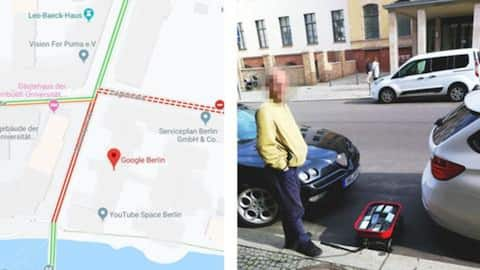Using 99 phones, he 'hacked' Maps to show fake traffic
What's the story
When it comes to exploring a city or looking up places, Google Maps serves as the one-stop shop to find routes/directions. The service works seamlessly but, like all things tech, even Maps can be hacked to mislead people. Case in point: A man who tricked Google Maps into showing fake traffic jam, with nothing but a cart full of phones. Here's all about it.
Trick
Experiment with a cart full of phones
As part of an 'experiment', artist Simon Weckert loaded as many as 99 phones running Google Maps in a small cart and asked a man to wheel that thing around the streets of Berlin. Then, as the man went along with the task, Weckert documented the traffic status for all the places he visited on Maps, just like we all do before heading somewhere.
Result
All streets turned red, indicating heavy traffic
While the streets were completely empty, Weckert noted that wherever the cart rolled, Google Maps thought that the place had a high concentration of people and start showing it in red - a virtual indicator for traffic jams. Even the slow movement of the cart contributed to the trickery, leading Google Maps into believing that the traffic was heavy and slow-moving.
Hack details
How was Google fooled?
Weckert managed to hack Google Maps into showing fake traffic jams by exploiting the basic ability of the service - data crowdsourcing. Google shows real-time traffic by sourcing and combining location/speed information from all Maps' users moving on a particular road. However, here, all the data came from the cart, which tricked Google into believing that these were separate users stuck in a jam.
Risk
This could be used for diverting people to alternate routes
While the hack appears harmless and hilarious at first, it is worth noting that a malicious actor can use this trick to show heavy traffic on one road, prompting Google to divert drivers to an alternate, albeit longer, route for faster travel. This might increase the traffic congestion on the other road while leaving the first one completely empty.
Response
Google has not commented on the matter
Google has not commented on the experiment video released by Weckert. However, Torrey Hoffman, a Senior Software Engineer involved in Google Maps' development, tweeted out that he knows about the internal working of the service and this kind of hack is certainly 'possible'. If that is indeed the case, Google should conduct an investigation and issue a fix immediately to prevent major exploits.
